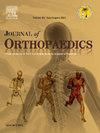Can intraoperative opioid use in hip and knee arthroplasty be reduced further without negatively affecting pain control: A case controlled study
IF 1.5
Q3 ORTHOPEDICS
引用次数: 0
Abstract
Background
Whilst forming the backbone of perioperative analgesic regimes in joint replacement surgery, the negative side effect profile of opioids is well known. Common impediments to a smooth running Enhanced Rapid Recovery model of care are often altered cognitive function and postoperative nausea and vomiting (PONV), both related to opioid use.
This study focuses on evaluating whether further reductions in intraoperative opioid use during joint arthroplasty can be safely achieved with minimal impact of such reductions on pain control and postoperative outcomes including opioid requirements and the incidence of PONV and ability to mobilise.
Method
Case controlled review of prospectively collected data assessing intraoperative opioid use, postoperative analgesic requirement, incidence of PONV and cognitive status as well as day 0 mobility postoperatively. 50 patients were randomized in the study and control groups.
Results
The study group received statistically significant lower dose of intraoperative opioids equivalent to 24.18 mg of Morphine compared to control group with equivalent to 69.58 mg of Morphine (p < 0.001). There was no statistically significant increase in analgesia requirement postoperatively and no negative influence on PONV or ability to follow immediate postoperative rehabilitative protocols.
Conclusion
Opioid use intraoperatively can be reduced even further without any compromise of postoperative pain control and PONV and may further reduce impediments to efficiency in rapid recovery models of care.
髋关节和膝关节置换术中阿片类药物的使用是否可以进一步减少而不影响疼痛控制:一项病例对照研究
背景阿片类药物作为关节置换术围手术期镇痛方案的骨干,其副作用是众所周知的。增强快速恢复护理模式顺利运行的常见障碍通常是认知功能改变和术后恶心和呕吐(PONV),两者都与阿片类药物使用有关。本研究的重点是评估在关节置换术中进一步减少阿片类药物的使用是否可以安全地实现,同时减少对疼痛控制和术后结果的影响最小,包括阿片类药物的需求、PONV的发生率和活动能力。方法对前瞻性收集的数据进行病例对照分析,评估术中阿片类药物的使用、术后镇痛需求、PONV的发生率、认知状况以及术后第0天的活动能力。50例患者随机分为研究组和对照组。结果研究组术中阿片类药物相当于吗啡的剂量为24.18 mg,对照组术中阿片类药物相当于吗啡的69.58 mg (p <;0.001)。术后镇痛需求无统计学显著性增加,对PONV或术后立即康复方案的能力无负面影响。结论在不影响术后疼痛控制和PONV的情况下,可以进一步减少术中阿片类药物的使用,并可能进一步减少快速恢复护理模式效率的障碍。
本文章由计算机程序翻译,如有差异,请以英文原文为准。
求助全文
约1分钟内获得全文
求助全文
来源期刊

Journal of orthopaedics
ORTHOPEDICS-
CiteScore
3.50
自引率
6.70%
发文量
202
审稿时长
56 days
期刊介绍:
Journal of Orthopaedics aims to be a leading journal in orthopaedics and contribute towards the improvement of quality of orthopedic health care. The journal publishes original research work and review articles related to different aspects of orthopaedics including Arthroplasty, Arthroscopy, Sports Medicine, Trauma, Spine and Spinal deformities, Pediatric orthopaedics, limb reconstruction procedures, hand surgery, and orthopaedic oncology. It also publishes articles on continuing education, health-related information, case reports and letters to the editor. It is requested to note that the journal has an international readership and all submissions should be aimed at specifying something about the setting in which the work was conducted. Authors must also provide any specific reasons for the research and also provide an elaborate description of the results.
 求助内容:
求助内容: 应助结果提醒方式:
应助结果提醒方式:


